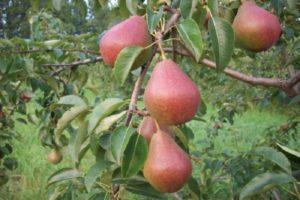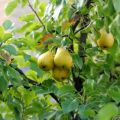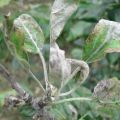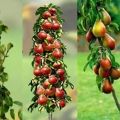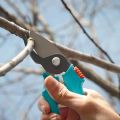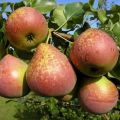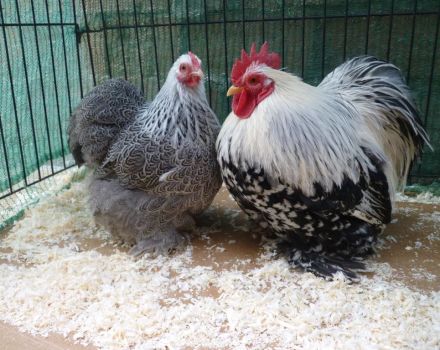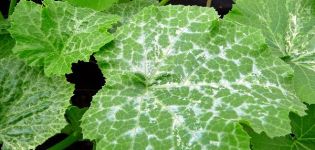Description and characteristics of pear varieties Rogneda, cultivation features
Russian gardeners love to grow the Roganda pear variety on their plots. It is known not only for its excellent taste and aroma, but also for its excellent adaptability to Russian climatic conditions.
The Rogneda pear is an unpretentious tree that can please a gardener with a good harvest.
Description and characteristics of Rogned pear
The variety has the following features.
Wood
Roganda pears are medium-sized. The crown is compact, foliage of medium density. The tree can be in the form of a wide pyramid or round-oval.
This variety is characterized by the fact that at least 70% of the buds are awakened. At the same time, the ability to grow varietal shoots is low and is estimated at 10%.
Weakly curved shoots are brown-green in color. Their structure is geniculate. Lentils are few in number. They are medium-sized and elongated.
The foliage is dark green and medium in size. The shape of the leaves is obovate. The edges are finely serrated.
Flowers have high resistance to sudden spring weather changes.
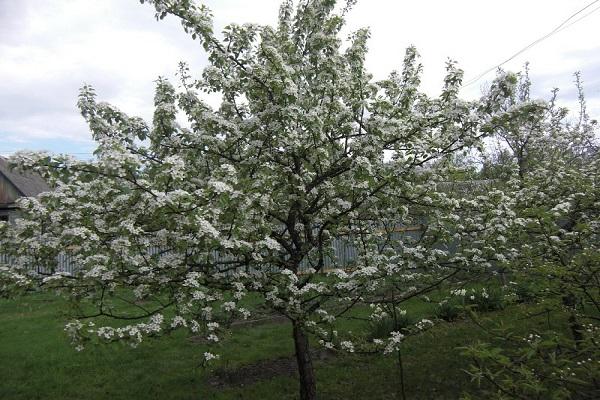
Fruit
Most of the fruits ripen on young ringlets. The petioles of pears are of medium length and thickness. The fruits are medium in size. The weight is 120-140 grams. Most of the fruits are round, although flat-round or broad-rhombic are found.
The smooth, shiny skin is characterized by medium thickness and firmness.
When the crop is ripe, the fruits are yellow. In some cases, the lighted side of the fruit may take on a red tint.
There are many small points under the skin. The funnel and saucer are small, they have a mild shape.
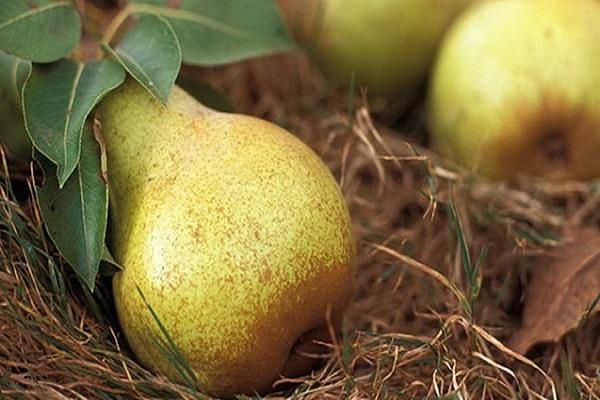
The pulp is creamy, slightly oily consistency.
The pear has a sweet taste, and the sourness is almost completely absent. The peculiarity of this variety is its excellent nutmeg aroma..
Yield
The fruits of Rogneda are harvested in the second and third decade of August. It is important to take into account that pears reach consumer maturity only by the end of the specified period.
The fruits are able to overripe quickly. After that, they crumble. If they are harvested later than the term, the storage time is sharply reduced. Therefore, such a practice has developed when the crop is harvested a little immature, then it is kept for full ripening for 10-20 days at ordinary temperature, then placed in a storage place where a lower temperature should be provided.The shelf life here is two months.

This pear is fast-growing. After planting seedlings in the third or fourth year, you can already harvest the tree from the tree.
The yield reaches 140 centners per hectare.
Assignment of the variety
The fruits can be eaten immediately after harvest. Fully ripe fruits can be used for processing. High-quality juices, preserves and jams are obtained from pears of this variety.
Advantages and disadvantages of wood
Among the advantages of this pear variety are the following:
- early maturity;
- excellent taste and aroma of pears;
- excellent winter hardiness;
- resistance to some types of insect pests and diseases.
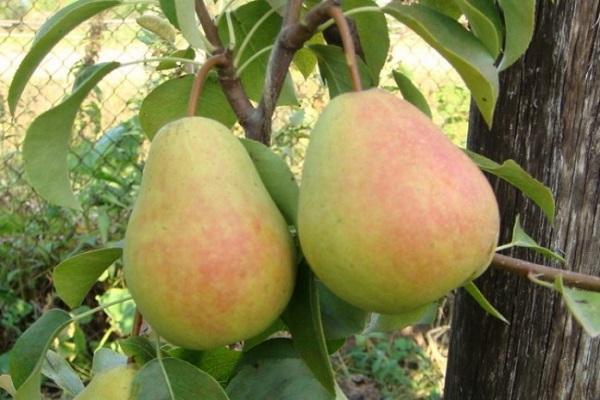
This variety has disadvantages. These include:
- clearly expressed periodicity during fruiting;
- shedding of ripe fruits;
- dim color of ripe fruits, which reduces the commercial qualities of pears of this variety.
Features of growing varieties
Properly organized planting of seedlings will allow you to get a healthy and productive tree.
Location determination
This pear variety is undemanding when choosing a soil. It shows good yields on both sandy and heavy clay soils..
They will feel better in an area that is well lit by the sun and protected from strong winds.
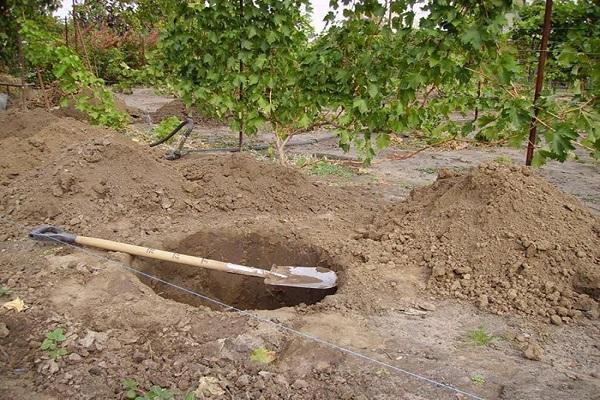
Selection and preparation of planting material
Choose seedlings without visible damage with a developed root system
Landing dates
You can plant seedlings in the spring, when the earth warms up or in the fall, no later than a month before the onset of winter cold weather.
Planting process
Since the crown has an average size, the seedlings can be planted at a distance of 4 meters from each other. It is necessary to ensure that the distance to the fence or wall is at least three meters.
Pits for seedlings are prepared 3-4 months before planting. The depth should be 60 centimeters and the length and width should be 80 centimeters. Two-thirds of the depression is covered with high-quality, fertile soil, which must be mixed with fertilizers.
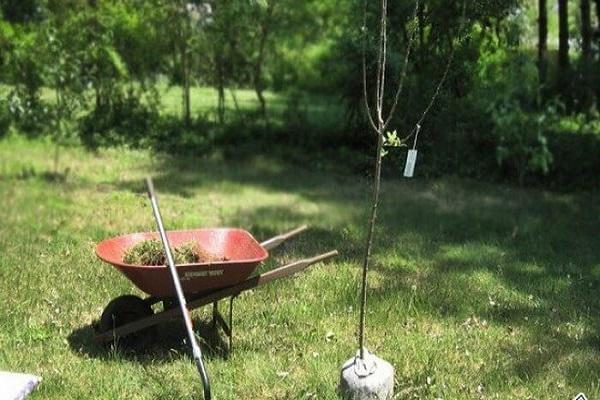
As a result, the soil will gradually settle, and the fertilizers will dissolve in the ground. When planting, the seedling is tied to a peg.
Pollinators
This variety is self-pollinated. It gives good yields even when there are no other pear varieties in the immediate vicinity.
Further care of the pear
With quality care, you can count on getting a good harvest of delicious pears.
Pruning
These varieties do not thicken strongly. Therefore, only formative pruning is performed, which is carried out only in the first 3-4 years of the tree's life.
Sometimes it becomes necessary to carry out sanitary pruning for old, dry or diseased branches.
Pruning is done in late autumn or during the winter.

Watering and feeding
Pear Rogneda is able to tolerate a lack of moisture well. However, to improve the quality of the fruit, it is recommended that two waterings be made during the season - before flowering and immediately after it ends.
Top dressing is performed starting from the second year of the plant's life. In early spring, it becomes necessary to feed with urea. During June, one more top dressing is carried out - sprayed with sodium humate. To do this, dissolve a tablespoon of the substance in a bucket of water.
When the end of September comes, 150 grams of superphosphate is poured into the trunk circle. This should be done at a distance of 25-30 centimeters from the tree trunk.
When the pear becomes an adult tree, feeding is carried out as follows:
- In April, 400 grams of dry urea is poured under the tree.
- When flowering begins, a complex mineral fertilizer is applied.
- After the end of flowering, nitrophoska is used for feeding.
- When the crop has already been harvested, one more top dressing must be done. To do this, potassium-phosphorus feeding is introduced into the near-trunk circle.

Loosening and mulching
Loosening of the soil and mulching must be carried out after watering, and the rest of the time - as needed.
Preparing for the winter period
This plant has high winter hardiness and does not require special measures for warming in the winter. However, it is recommended to paint the trunk with lime to keep out rodents.
Diseases, pests and methods of dealing with them
This pear variety is known for its high resistance to scab disease. This variety also has resistance to other diseases and pests, although to a lesser extent. To combat them, you can use folk methods and only in case of failure, resort to insecticides and other chemicals.
Rogneda pear harvesting and storage
Harvest without waiting for full maturity. High-quality, undamaged fruits are selected for storage. The rest are eaten or processed. Pears can be stored for a maximum of three months.

